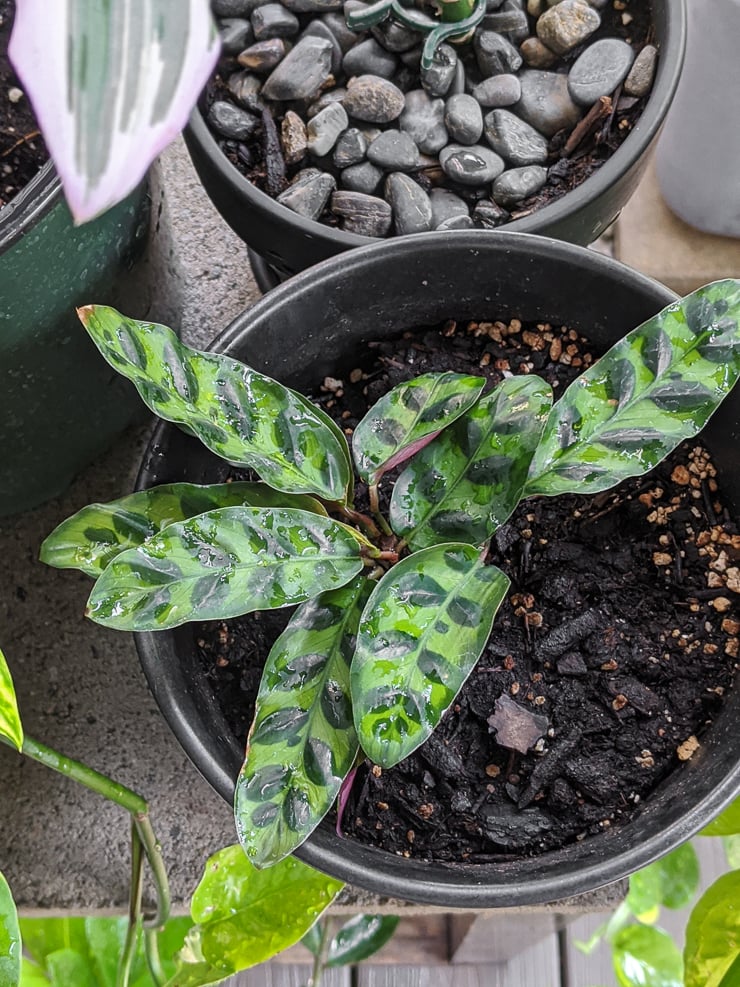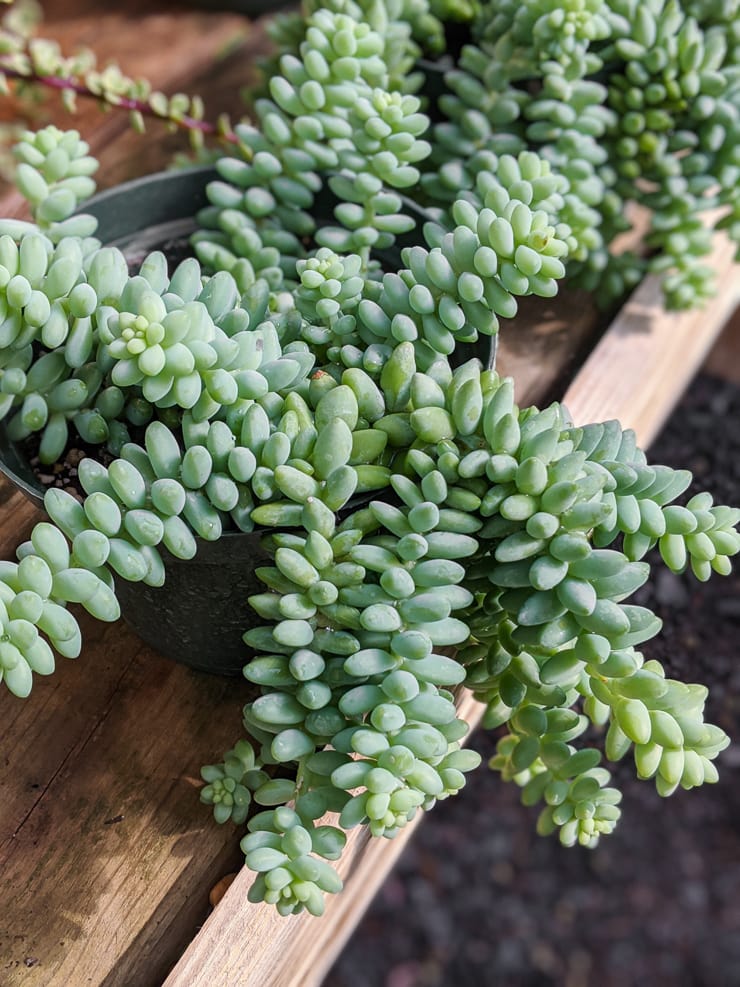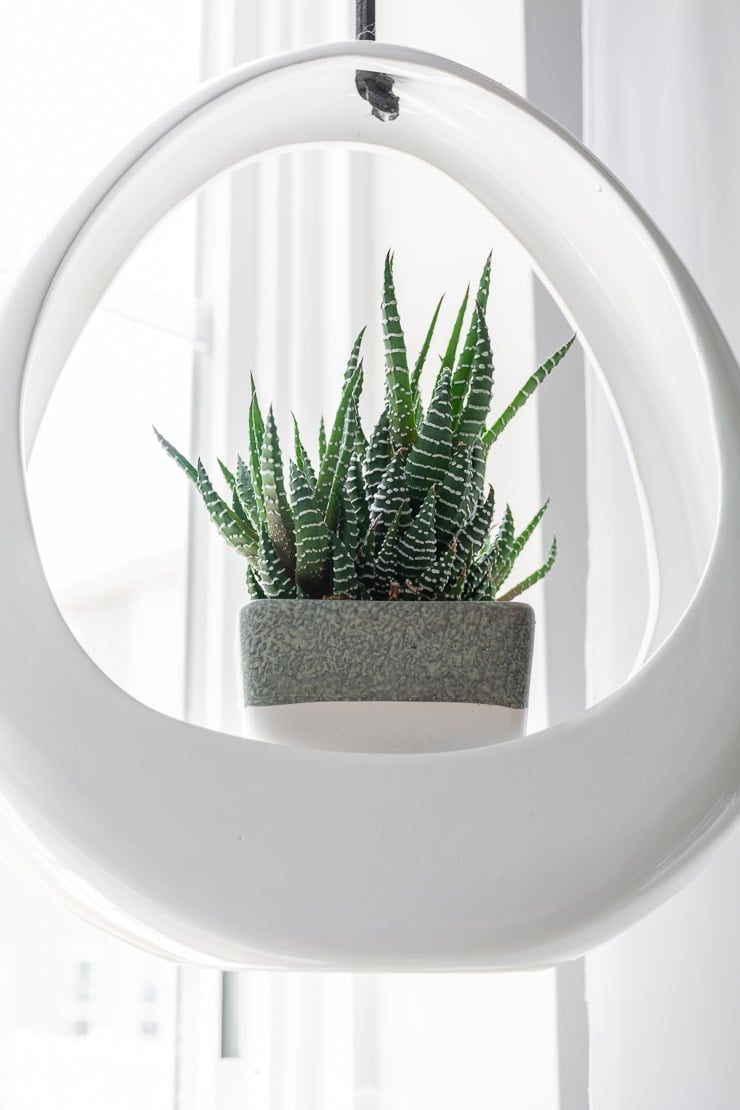Are you wondering what house plants are safe to have around your cats? Here are 16 non-toxic plants for cats, as well as links to detailed care guides and more!
Non-Toxic Plants for Cats: 16 Cat-Safe House Plants!
Hey fellow kitty lovers, today I’m sharing a roundup of 16 non-toxic plants for cats that you can add to your home! I get this question from people a lot—what house plants are safe for cats? There are plenty. Today I’m outlining 16 of my favorites that I’ve actually owned and cared for. I’m also linking to detailed care or propagation guides.

If you want this information in one easy-to-follow, printable version, I also sell an e-book called The Pet Owner’s Houseplant Guide that you can check out!
If that’s not your thing, never fear—I’ll give you a slimmed-down version of what you need to know right here! So let’s jump into it and learn about which houseplants you and your kitties can peacefully coexist with.
16 Non-Toxic Plants for Cats
1. Ponytail Palm Plants
The ponytail palm—aka beaucarnea recurvata—is a patient, drought-tolerant plant that has a lovely tropical look to it. But it’s actually a succulent! It stores water in its bulbous trunk that looks a bit like an elephant’s foot (which is why it’s also called an elephant’s foot plant).
This plant requires little water and has a shallow root system—it enjoys a well-draining succulent soil. It’s long, curly leaves sprout from rosettes and give it a bouncy ponytail look. It likes a lot of light. Check out my detailed ponytail palm care guide.

2. Spider Plants
Spider plants are a houseplant staple. They are easy to grow and are patient with their care conditions. As a bonus, they sprout stems with baby spider plants on them. You can cut these off, easily root them, and propagate them to grow new spider plants!

3. Peperomia Plants
There are loads of different peperomia plants out there, and I’ve owned quite a few varieties. I like peperomia plants because they stay pretty small, making them great desktop plants. Propagating peperomia plants is also easy.
Different varieties do well in a variety of lighting conditions from bright light to even lower light conditions. Mine have generally done very well in bright-to-medium indirect light. Check out my peperomia care guide for more.


4. Pilea Peperomioides
Pilea peperomioides—aka Chinese money plants—are really cool-looking houseplants. They are also sometimes called “UFO” plants because their leaves look like saucers that sprout from the main stem.
This plant also sends runnings under the soil to sprout new baby pilea plants. You can leave these on to give the plant a fuller look, or you can cut them off to propagate! See my pilea peperomioides care post for more.


5. Calathea Plants
Man do I have a love-hate relationship with calathea plants. I love to look at them, but I kind of hate to care for them. They really like high humidity, and I struggle to keep them happy in my dry house. Even with a humidifier.
Nevertheless, they are gorgeous plants that come in a number of different varieties. Many are pretty easy to find at garden centers or nurseries year-round. Good luck to you with these drama queens 🙂 Take a look at my calathea plant care guide for more.



6. Hoya Carnosa Plants
Hoya carnosa plants, also known as wax plants, have been houseplant staples for quite a while. They are super low maintenance and come in a variety of different colors and variegations. I have a few varieties, all of which do really well in medium-to-bright light. You can see my hoya carnosa plant post for more.


7. Hoya Rope Plants
Hoya rope plants are actually a variety of hoya carnosa! Their full name is hoya carnosa compacta. The leaves are crinkled and twisted, much like ropes. It’s a really cool-looking plant that can be hard to find in versions that aren’t super tiny. I got my big one from a friend who sent it to me from a nursery in Texas! Check out my hoya rope plant care guide.


8. Air Plants
Air plants—aka tillandsia—are unique because you can display them in some really cool ways. They don’t need soil and are watered by misting them or soaking them in a sink occasionally. I love that I don’t have to worry about overwatering them and having soaked soil.
Air plants also come in different varieties—and they grow flowers! I have had one of my air plants flower, and it’s pretty cool. Tillandsia xerographica is a chunky variety and is the easiest to care for, in my opinion. It doesn’t dry out as quickly as the others, and the leaves have a gorgeous shimmery finish. See my detailed air plant care guide for more.


9. Burro’s Tail Succulents
Burro’s tail succulents are a gorgeous trailing succulent that look awesome in hanging planters. Mine has grown a ton this year hanging right in front of a sunny window, and they are also super easy to propagate (just like other succulents).
Like a lot of other succulents, burro’s tail plants are easy to care for. They like a lot of light and do not need much water or humidity. All around, they are a win. Check out my burro’s tail succulent guide for more.

10. Rhipsalis Trailing Cactus
Another awesome succulent/cactus plant—the rhipsalis trailing cactus, aka mistletoe cactus—this one also looks amazing in hanging planters. I’ve actually got mine hung up in front of the same sunny window I’ve got my burro’s tail succulent in.
There are a couple of different beautiful varieties to choose from. I have three different varieties and love them all—their leaves are all just a bit different, but they all have a gorgeous trailing pattern. See my rhipsalis trailing cactus care guide for more on the popular varieties and how to care for them!



11. Ric Rac Cactus
This gorgeous plant was on my wishlist for a while—the ric rac cactus, also often referred to as the fishbone cactus. It’s “leaves” are actually stems! They have a cool zig-zag shape that sprout from the center of the plant. And man do they look awesome hanging in a planter!
They need a bit more water than traditional cactuses and like a lot of sun. They also enjoy some humidity because they are a tropical cactus. Give your ric rac a misting every now and then to keep it happy. See my detailed ric rac cactus care guide for more care tips.

12. Night-Blooming Cereus
I first encountered this plant at my grandmother’s house. It’s a cool orchid-like cactus that blooms large gorgeous flowers only at night. Its leaves also trail down and cascade over the edge of planters, making it idea for hanging or setting on top of a tall shelf. See my night-blooming cereus care guide for more.


13. Curly Orchid Cactus
The curly orchid cactus is closely related to the night-blooming cereus plant. Its stems are actually a mutation—they resemble long, curly locks of hair. I have one in a hanging planter and think it looks great. This one is also very easy to propagate from cuttings. See my full curly orchid cactus care guide for more.

14. Holiday Cactus
Holiday cactus plants—whether Christmas, Thanksgiving, or Easter— can live for very long and bloom around the holiday they are named after. Christmas cactuses are probably the most common, but often Thanksgiving cactuses are sold mislabeled as Christmas cactuses.
These are very easy to propagate; mine is actually a plant grown from a cutting of my grandma’s Thanksgiving cactus. It bloomed last year, and I’m hoping it blooms again this year! See my holiday cactus care guide for more info.

15. Lipstick Plants
Lipstick plants are a more recent addition to my plant collection. My favorite variety is the curly/rasta variety—I’ve got it hanging in front of a window that gets bright morning sun, and it’s doing great.
Lipstick plants are named after their flowers, which often look like bright lipstick tubes! These plants are also super patient. They aren’t super picky with lighting needs and tolerate a certain level of neglect. Check out my lipstick plant care guide for more information, including tips on taking care of this plant and the different varieties you’ll likely find.


16. Haworthia Succulents
Last one! Haworthia succulents are seriously cute. They stay pretty small and are incredibly hardy. In their natural habitat, they can grow on rocky cliffs, so that tells you a lot about the level of neglect they can withstand. They are patient with different light levels and are very drought tolerant.
And there are tons of different varieties you’ll likely find in your local garden centers and nurseries. I provide an overview of the more common haworthia varieties in my haworthia plant care guide.


Pin my post about non-toxic plants for cats!



Brittany is a seasoned DIY home and garden expert, running a creative brand since 2014 that inspires others with approachable plant care guides, woodworking tutorials, and decor projects. She is a certified project manager and has completed extensive coursework in the art and science of growing your own plants. Her work has been recognized by major publications, and she routinely collaborates with fellow DIY industry leaders—but her favorite thing to do is inspire you! Learn more about her here.

Leave a comment